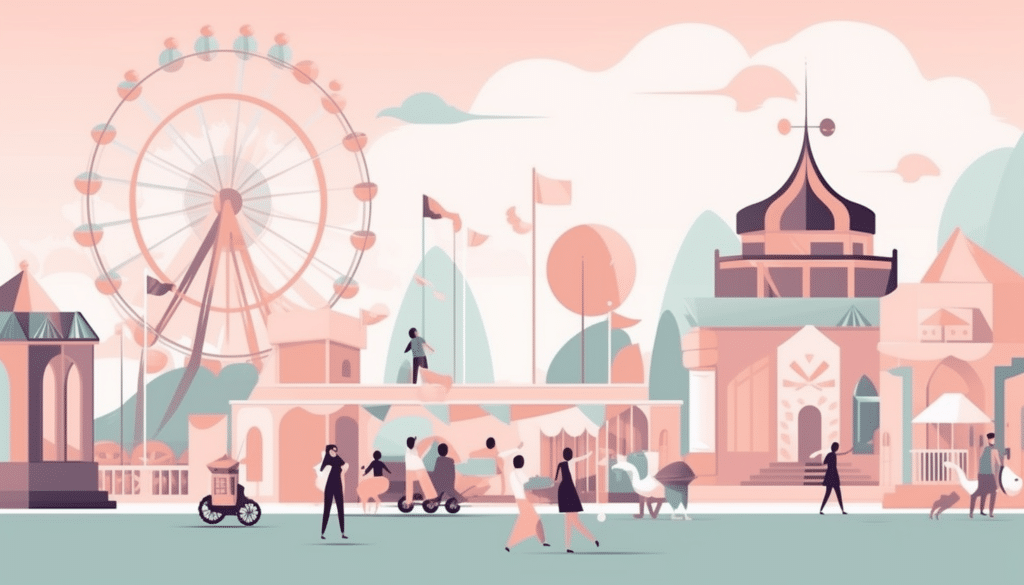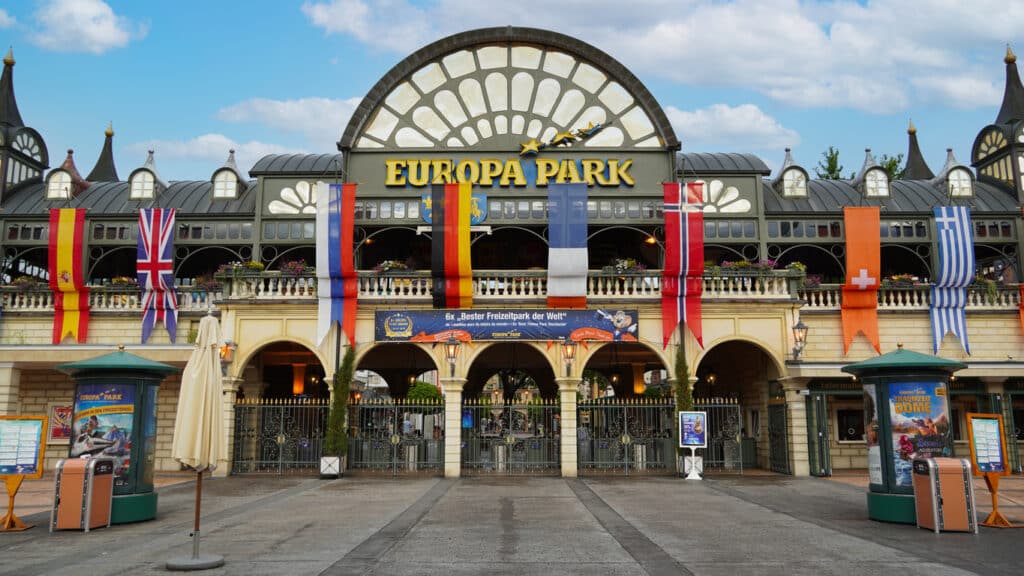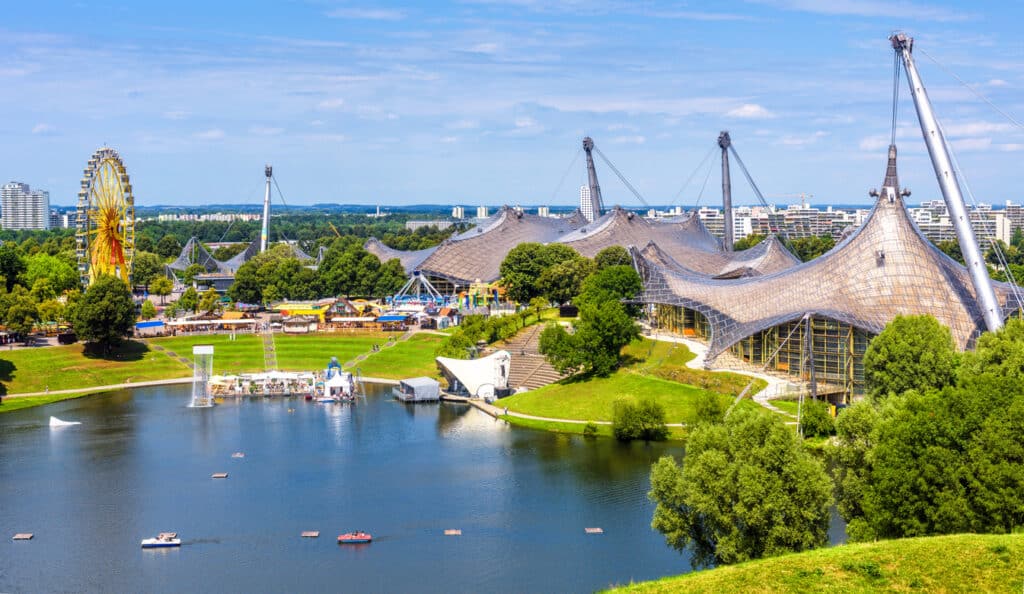Germany has seven theme parks that draw more than a million visitors a year: Europa Park, Phantasialand , Movie Park Germany, Heidepark, Legoland, Hansa-Park and Holiday Park.
Among the big things at the parks are the rides. They all have roller coasters, and many have rides that take you through haunted houses or fairyland, or off adventuring among gnomes, pirates, cannibals or Indians, sometimes on a “ship” that pitches with the waves. “Wild water rides” are also big, as are flight simulators, in which you seem to be speeding off somewhere without budging from a single spot. All parks have children’s playgrounds, and many have trains that help the visitors get around.
The parks also have extensive entertainment programs, including musicals, variety shows, animal shows, puppet shows, movies, laser shows, parades and circuses. And many have “foreign” areas; Italian piazzas, western towns, Dutch, Chinese or Scandinavian villages, usually with the appropriate food and drink.
Two of Germany’s largest film studios, at Munich and Babelsberg near Berlin, plus a Movie Park at Brühl, give visitors an inside look into the movie industry. They actually produce movies and TV shows and let visitors tour the facilities. At another park you can learn all about automobiles at Wolfsburg, the home town of Volkswagen. Or you can go on a realistic “safari” at Serengeti Park in Hanover.
Make no mistake about it, a family outing at one of the amusement parks will be an expensive undertaking. Figure on at least €125 for travel, admission, food and drink. Bringing a picnic lunch may knock something off the price, but souvenirs and candy can push the total even higher. And don’t try to “do” a park in less than four hours.
The price of admission ranges from about €20 to €30 per person. Children are usually admitted for less, but only slightly less. The admission price usually covers all rides and shows, though there can occasionally be an extra levy on some of these.
Smaller parks are less hectic and you usually don’t have to wait so long. Thursdays and Fridays are the least crowded days, and the parks are also less full during the first weeks of the school vacations. You also might find special rates, such as family days or a two-day ticket.
For links to all parks go to www.themeparkcity.com/EURO_germ.htm

A selection of some of Germany's best parks:
Europa Park
Europa Park, at Rust, north of Freiburg in the Black Forest, is Germany’s biggest park and the second biggest in Europe. Twelve European countries are represented on the 200-acre grounds, with everything from the architecture and culture to the plants, trees and flowers authentically reproduced. Its “Eurosat” takes you on a virtual journey past clusters of meteors and falling stars. (www.europapark.de)

Entrance gate to Europa Park Credit: Wirestock
Phantasialand
Phantasialand, at Brühl, near Cologne, is Germany’s second most visited theme park. Its “Space Center” gives you a ride to the moon, and its Temple of the Nighthawk” takes you on a ride through the black of night on the back of a virtual hawk. Its theme villages include Mexico, Old Berlin and Chinatown. (www.phantasialand.de)
Movie Park
This film and attraction park, at Bottrop between Düsseldorf and Dortmund, actually produces movies and TV shows, and you can learn all about the process. You’ll find five differently themed areas: “Thrills” (roller coasters), “Family&Kids” and “Wonderland Studios” (cartoon stars, kiddie carousels), “Water Fun” (water rides like “Ice Age Adventure”) and “Hollywood” (German Film Museum). One of its roller coasters is called “Lethal Weapon.” Enough said! (www.movieparkgermany.de)
Legoland Deutschland

Legoland Deutschland. Credit: mbbirdy
Legoland Deutschland, at Günzburg, near Ulm, is Germany’s own Lego amusement park and the fourth Legoland worldwide to be built by the noted Danish producer of toy building blocks. Among other things there are Neuschwanstein Castle, the Frankfurt skyline and the Hamburg harbor recreated in minute detail using Legos. Kids whom they inspire can take some Legos and build their own skyscraper, palace or whatever. Even the jungles, fairytale kingdoms or pirate coves are, unlike the other parks, built from Legos. (www.legoland.de)
Hansapark
Hansapark, at Sierksdorf near Lübeck, is the only theme park located at the seashore, and you can get a spectacular view of the sea from its Holstein Tower, the highest lookout point on the Baltic. It reminds us of the Hanseatic Lague, an alliance of cities that monopolized North European shipping during the late middle ages. It is creating a park of miniature buildings reminiscent of the times, and also has all the rides and amusements found at the other parks. (www.hansapark.de)
Hansapark
Heide Park is on the dreamy Lüneburg Heath at Soltau, about halfway along the Hamburg-Hannover Autobahn. It’s home to the world’s tallest drop tower, Scream, as well as Colossus, the steepest wooden roller coaster in the world. It is spectacularly landscaped, with flowerbed after flowerbed, hundreds of trees and shrubs, and a large lake at the center, and has the usual collection of rides, entertainment and dining. (www2.heide-park.de)
Holiday Park
Holiday Park at Haßloch, near Bad Durkheim in the Palatinate, is part park and part woodland. It receives more than 1.1 millions of visitors a year, and its Free Fall Tower was the first amusement ride of its kind in Europe. Its unique professional water-ski stunt show has a program full of breathtaking stunts and risky jumps. (www.holidaypark.de)


























